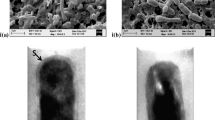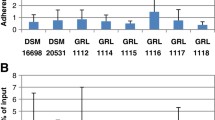Abstract
The objective of this study was the characterisation of the S-layer protein (SlpA) and its functional role in the probiotic activity of Lactobacillus helveticus M92. SlpA was isolated and identified by SDS-PAGE LC-MS/MS analysis. The slpA gene encoding the SlpA from L. helveticus M92 was sequenced and compared with other well characterised slpA genes. Sequence similarity searches revealed high homology with the SlpA of Lactobacillus strains. Purified SlpA showed significantly better immunomodulatory effects in orally immunised mice than L. helveticus M92 cells after SlpA removal. SlpA is involved in the autoaggregation of L. helveticus M92 cells and coaggregation of L. helveticus M92 with S. Typhimurium FP1 as these processes were negatively affected after SlpA removal from the cell surface. Therefore, the influence of oral treatment with L. helveticus M92 on an oral infection of mice by S. Typhimurium FP1 was investigated. Following the oral immunization of mice, with viable L. helveticus M92 and S. Typhimurium FP1 cells, the concentration in the luminal contents of total S-IgA and specific anti-Salmonella S-IgA antibodies, from all immunized mice was significantly higher compared to the control group or a group of mice infected only with S. Typhimurium FP1. These results demonstrate that the observed reduced infection by S. Typhimurium FP1 in mice with L. helveticus M92 is associated with competitive exclusion in the intestinal tract and enhanced immune protection conferred by the L. helveticus M92 and its SlpA.





Similar content being viewed by others
References
Åvall-Jääskeläinen S, Palva A (2005) Lactobacillus surface layers and their applications. FEMS Microbiol Rev 29:511–529
Åvall-Jääskeläinen S, Hynönen U, Ilk N, Pum D, Sleytr UB, Palva A (2008) Identification and characterization of domains responsible for self-assembly and cell wall binding of the surface layer protein of Lactobacillus brevis ATCC 8287. BMC Microbiol 8(165):1–15
Beganović J (2008) Application of proteomics and other molecular methods in the characterisation of functionality of the probiotic bacteria. Dissertation, University of Zagreb
Beganović J, Guillot A, van de Guchte M, Jouan A, Gitton C, Loux V, Roy K, Huet S, Monod H, Monnet V (2010) Characterization of the insoluble proteome of Lactococcus lactis by SDS-PAGE LC-MS/MS leads to the identification of new markers of adaptation of the bacteria to the mouse digestive tract. J Proteome Res 9:677–688
Boesten RJ, de Vos WM (2008) Interactomics in the human intestine: Lactobacilli and Bifidobacteria make a difference. J Clin Gastroenterol 42(Suppl 3 Pt 2):S163–S167
Bradford M (1976) A rapid and sensitive method for the quantitation of microgram quantities of protein utilizing the principle of protein-dye binding. Anal Biochem 72:248–254
Buck BL, Altermann E, Svingerud T, Klaenhammer TR (2005) Functional analysis of putative adhesion factors in Lactobacillus acidophilus NCFM. Appl Environ Microbiol 71(12):8344–8351
Casey PG, Casey GD, Gardiner GE, Tangney M, Stanton C, Ross RP, Hill C, Fitzgerald GF (2004) Isolation and characterisation of anti-Salmonella lactic acid bacteria from porcine gastrointestinal tract. Lett Appl Microbiol 39:431–438
Chen XY, Xu JJ, Shuai JB, Chen JS, Zhang ZF, Fang WH (2007) The S-layer proteins of Lactobacillus crispatus strain ZJ001 is responsible for competitive exclusion against Escherichia coli O157: H7 and Salmonella typhimurium. Int J Food Microbiol 115:307–312
Coconnier MH, Lievin V, Lorrot M, Servin AL (2000) Antagonistic activity of Lactobacillus acidophilus LB against intracellular Salmonella enterica serovar Typhimurium infecting human enterocyte-like Caco-2/TC-7 cells. Appl Environ Microbiol 66:1152–1157
Delcour J, Ferain T, Deghorain M, Palumbo E, Hols P (1999) The biosynthesis and functionality of the cell-wall of lactic acid bacteria. Antonie van Leeuwenhoek 76:159–184
Fayol-Messaoudi D, Berger CN, Coconnier-Polter MH, Liévin-Le Moal V, Servin AL (2005) pH-, lactic acid-, and non-lactic acid-dependent activities of probiotic lactobacilli against Salmonella enterica Serovar Typhimurium. Appl Environ Microbiol 71(10):6008–6013
Frece J, Kos B, Svetec IK, Zgaga Z, Mrsa V, Šušković J (2005a) Importance of S-layer proteins in probiotic activity of Lactobacillus acidophilus M92. J Appl Microbiol 98:285–292
Frece J, Kos B, Beganović J, Vuković S, Šušković J (2005b) In vivo testing of functional properties of three selected probiotic strains. World J Microbiol Biotechnol 21:1401–1408
Frece J, Kos B, Svetec IK, Zgaga Z, Beganović J, Leboš A, Šušković J (2009) Synbiotic effect of Lactobacillus helveticus M92 and prebiotics on the intestinal microflora and immune system of mice. J Dairy Res 76:98–104
Golowczyc MA, Mobili P, Garrote GL, Abraham AG, De Antoni GL (2007) Protective action of Lactobacillus kefir carrying S-layer protein against Salmonella enterica serovar Enteridis. Int J Food Microbiol 118:264–273
Grogono-Thomas R, Blaser MJ, Ahmadi M, Newell DG (2003) Role of S-layer protein antigenic diversity in the immune responses of sheep experimentally challenged with Campylobacter fetus subsp. Fetus. Infect Immun 71:147–154
Hajduk G, Kos B, Šušković J, Frece J, Leboš A, Beganović J (2009) Probiotic properties of Bifidobacterium animalis subsp. lactis BB-12 in baby cereal flakes enriched with inulin. Ital J Food Sci 4(21):473–486
Horie M, Kajikawa HS, Toba T (2002) Identification of Lactobacillus crispatus by polymerase chain reaction targeting S-layer protein gene. Lett Appl Microbiol 35(1):57–61
Johnson-Henry KC, Hagen KE, Gordonpour M, Tompkins TA, Sherman PM (2007) Surface-layer protein extracts from Lactobacillus helveticus inhibit enterohaemorrhagic Escherichia coli O157:H7 adhesion to epithelial cells. Cell Microbiol 9(2):356–367
Kos B, Šušković J, Goreta J, Matošić S (2000) Effect of protectors on the viability of Lactobacillus acidophilus M92 in simulated gastrointestinal conditions. Food Technol Biotechnol 36:121–127
Kos B, Šušković J, Vuković S, Šimpraga M, Frece J, Matošić S (2003) Adhesion and aggregation ability of probiotic strain Lactobacillus acidophilus M92. J Appl Microbiol 94:981–987
Kos B, Šušković J, Beganović J, Gjuračić K, Frece J, Iannaccone C, Canganella F (2008) Characterization of the three selected probiotic strains for the application in food industry. World J Microbiol Biotechnol 24:699–707
Lebeer S, Vanderleyden J, De Keersmaecker SCJ (2008) Genes and molecules of lactobacilli supporting probiotic action. Microbiol Mol Biol Rev 72(4):728–764
Leboš Pavunc A, Beganović J, Kos B, Buneta A, Beluhan S, Šušković J (2010) Influence of microencapsulation and transglutaminase on viability of probiotic strain Lactobacillus helveticus M92 and consistency of set yoghurt. Int J Dairy Techol 76 (in press). doi:10.1111/j.1471-0307.2010.00647.x
Liu TS, P Zhang, Ma Y, Qin H (2010) Lactobacillus plantarum surface layer adhesive protein protects intestinal epithelial cells against tight junction injury induced by enteropathogenic Escherichia coli. Mol Biol Rep. doi:10.1007/s11033-010-0457-8
Martínez B, Sillanpää J, Smit E, Korhonen TK, Pouwels PH (2000) Expression of cbsA encoding the collagen-binding S-protein of Lactobacillus crispatus JCM5810 in Lactobacillus casei ATCC 393T. J Bacteriol 182(23):6857–6861
Mobili P, Serradell MA, Trejo SA, Puigvert FXA, Abraham GA GL, Antoni De (2009) Heterogeneity of S-layer proteins from aggregating and non-aggregating Lactobacillus kefir strains. Antonie van Leeuwenhoek 95:363–372
National Research Council (1996) Guide for the care and use of laboratory animals. Institute of Laboratory Animal Resources, National Academy Press, Washington, DC
Perdigón G, Locascio M, Medici M, Pesce de Ruiz Holgado A, Oliver G (2003) Interaction of bifidobacteria with the gut and their influence in the immune function. Biocell 27:1–9
Racedo S, Villena J, Medina M, Agüero G, Rodríguez V, Alvarez S (2006) Lactobacillus casei administration reduces lung injuries in a Streptococcus pneumoniae infection in mice. Microbes Infect 8:2359–2366
Servin AL, Coconnier MH (2003) Adhesion of probiotic strains to the intestinal mucosa and interaction with pathogens. Best Pract Res Clin Gastroenterol 17(5):741–754
Šušković J, Kos B, Matošić S, Besendorfer V (2000) The effect of bile salts on survival and morphology of potential probiotic strain Lactobacillus acidophilus M92. World J Microbiol Biotechnol 16:673–678
Šušković J, Kos B, Goreta J, Matošić S (2001) Role of lactic acid bacteria and bifidobacteria in synbiotic effect. Food Technol Biotechnol 39:227–235
Šušković J, Kos B, Beganović J, Leboš Pavunc A, Habjanič K, Matošić S (2010) Antimicrobial activity—the most important property of probiotic and starter lactic acid bacteria. Food Technol Biotechnol 48(3):296–307
Van der Mei HC, van de Belt-Gritter B, Pouwels PH, Martinez B, Busscher HJ (2003) Cell surface hydrophobicity is conveyed by S-layer: a study in recombinant lactobacilli. Colloids Surf B Biointerfaces 28:127–134
Vidgrén G, Palva I, Pakkanen R, Lounatmaa K, Palva A (1992) S-layer protein gene of Lactobacillus brevis: cloning by polymerase chain reaction and determination of the nucleotide sequence. J Bacteriol 174(22):7419–7427
Yoneda M, Hirofuji T, Motooka N, Nozoe K, Shigenaga K, Anan H, Miura M, Kabashima H, Matsumoto A, Maeda K (2003) Humoral immune responses to S-layer-like proteins of Bacteroides forsythus. Clin Diagn Lab Immunol 10:383–387
Acknowledgments
The authors are grateful for the financial support provided by Ministry of Science, Education and Sports of the Republic of Croatia (Project 0581990 “Probiotics, prebiotics and functional starter cultures”). The authors wish also to thank to the staff of PAAPSO, INRA Jouy en Josas, France for mass spectrometry analysis. Jasna Beganović was recipient of a Marie Curie fellowship for Early Stage Research Training, inside LABHEALTH (MEST-CT-2004-514428).
Conflict of interest
None.
Author information
Authors and Affiliations
Corresponding author
Rights and permissions
About this article
Cite this article
Beganović, J., Frece, J., Kos, B. et al. Functionality of the S-layer protein from the probiotic strain Lactobacillus helveticus M92. Antonie van Leeuwenhoek 100, 43–53 (2011). https://doi.org/10.1007/s10482-011-9563-4
Received:
Accepted:
Published:
Issue Date:
DOI: https://doi.org/10.1007/s10482-011-9563-4




